|
| late June -- Creating the yamadai |
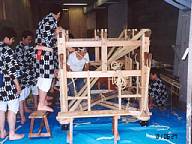 |
The yamadai (wooden frame of the kakiyama = race
float) is built by well-skilled yama-daiku (carpenters) using
ropes and wedges and without a single nail.
To firmly support the yamadai, ropes called yatsu-monji-nawa
are tied to the top and bottom of the four legs of to the yamadai. |
| This sturdy structure even against accidental
impact has been created by the wisdom of predecessors. |
 |
| early July -- Boujime |
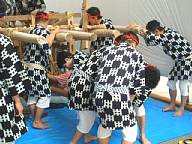 |
Six kaki-bou (bars) are set on top of the yama-dai
with thick ropes of hemp, again without using a single nail. This
process is called Boujime. After Boujime, is finished,
the yama-dai is decorated with a doll and various ornaments. |
|
Then, a ceremony called Goshin-ire is held. With the
completion of Goshin-ire, the kaki-yama becomes
the object of worship. In the case of Daikoku-nagare, from
this day on, the kaki-yama will be guarded nightly by men
represented from each region on rotation. |
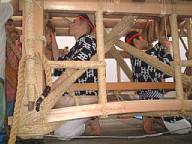 |
 |
| July 9 -- Oshioi-tori |
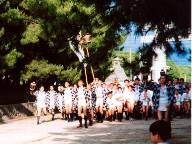 |
Praying for safety during the festival, men of all ages visit the
shores at Hakozaki Shrine to bring back purified sand called
oshioi. The choochin (paper lanterns) are lit, and
all men return to Kushida Shrine around 7:00 p.m. |
| Since each nagare (team) and its regions
have their own design of happi and choochin, the
number of designs becomes numerous. There is no doubt that each
man has pride of his own design. |
 |
 |
 |
| July 10 -- Nagare-gaki |
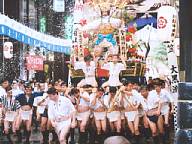 |
This is the first day to carry the kaki-yama (race float).
The kaki-yama weighs approximately one ton (including four
to six daiagari = conductors who sit on its top), and is
carried by about 26 men (28 men in some nagare). The kaki-yama
moves fast by the pushing power of ato-oshi. |
| The kaki-yama is carried to every
region of Daikoku-nagare. All of the men become excited with
the first experience of the year. |
 |
| July 11 -- Asa-yama |
|
|
Asa-yama is the event to show respect to elders by offering
festive meals and assigning them to the honorary daiagari position.
It is also called Shuugi-yama (celebrative yamakasa).
In the case of Daikoku-nagare, each chou-sodai (representatives
of each region) receives the meal wearing the costume called |
| toshiyori-katabira (a single-layered
kimono made from hemp) and often become daiagari wearing
it. |
 |
| July 11 -- Tanagare-gaki |
|
|
Tanagare-gaki is the event in which each team carries its
float into the areas of the other teams. During the event, Daikoku-nagare
performs Kushida-iri (a short lap around the ground of Kushida
Shrine) for the first time of the year.
Nishi-nagare, Ebisu-nagare and Doi-nagare
do not conduct Tanagare-gaki. |
 |
| July 12 -- Oiyama-narashi |
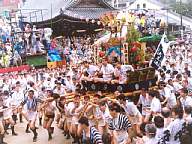 |
Oiyama-narashi may be considered the rehearsal
of Oiyama@(final race). All of the men carry their own float
and run with all of their might through the streets of Hakata. They
all have strong pride of their own team, and are extremely serious. |
 |
| July 13 -- Shuudan-yamamise |
 |
On this particular event, the kaki-yama leaves the Hakata
area (merchantsf town) and enters Fukuoka area (a castle town). The
honor of daiagari is offered to famous persons of Fukuoka for this
event.
Meiji-doori (avenue), the course of Shuudan-yamamise, is
crowded with many spectators every year. |
| In the case of Daikoku-nagare, soon after Shuudan-yamamise,
Tsuizen-yama ceremony is held, in which the kaki-yama
is brought to the houses of former chou-sodai and former
torishimari who have deceased within the year. |
| In front of each alter of the deceased, all of the men sing
together a song called Iwai-medeta (Hakata Iwai-uta),
and burn incense for the soul of the deceased. After Tsuizen-yama,
Kourou-yama ceremony is also held at the touban-cho
(region in charge) headquarters, in which a memorial service is
cooperatively held for the deceased who have contributed to Daikoku-nagare. |
|
 |
| July 14 -- Nagare-gaki |
| |
Similarly to Nagare-gaki held on July 10,
the kaki-yama is carried to every region of Daikoku-nagare.
Higashi-nagare and Chiyo-nagare do not conduct nagare-gaki. |
 |
| July 15 -- Oiyama |
| 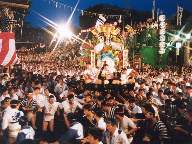 |
At the dawn on the 15th, the final race called Oiyama is
performed. At 4:59 a.m., the first nagare (team) carries their float
and dashes into Kushida Shrine on the signal of a drum beat. |
| Time is measured for (1) short track, Kushida-iri (a lap
around the grounds of Kushida Shrine from the entrance to
the exit, and (2) long distance (a course of approximately five kilometers).
Following the first nagare, each nagare performs the Oiyama
every five minutes (starting time from 5:05, 5:10, 5:15, 5:20, 5:25,
and 5:30 respectively). Only the first nagare stops the float inside
Kushida Shrine, turns toward Noh stage, sings together the
Iwai-medeta song, and restarts the race. There is a six minute
time lag between the starting time of the first and second nagare
because one minute is kept for the song. |
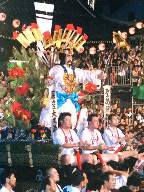 |
 |
| After Oiyama |
|
After arriving at the goal of the long distance course (called mawari-dome),
each team returns the float to its own nagare headquarters.
In the case of Daikoku-nagare, all of the ornaments including
the doll are removed from the float, and the yama-dai (wooden
frame) is passed to the next toban-chou. |
| Then, the yama-dai is quickly dismantled without
a trace. It is quite striking that the kaki-yama is destroyed
so quickly without hesitation. However, all of the men look forward
to the new one of the next year. |
 |
|